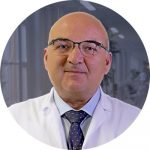15 December, 2021
Orthopaedic surgery that’s more and more personalised
The great development in technology and research in the last few years has allowed us to implement more and more personalized medicine, made to measure for each patient. It is a focus that is helping to improve the results obtained. Orthopaedic surgery is one of the fields in which this development has been notable. In barnaclínic+ there is a group of first rate professionals, as well as cutting-edge technology, which allows them to offer all patients the most adapted services according to their needs. Personalised orthopaedic surgery.
TECHNOLOGY HELPS TO IMPROVE RESULTS
Without doubt one of the areas in which this development has advanced in 3D technology. “It’s about something which is more important in our speciality and from years ago we’ve been working on its application in order to be able to make medicine more personalised”, explains Dr. Pere Torner, head of Orthopedic and Traumatologic Surgery Services at Hospital Clínic Barcelona and one of the professionals at barnaclínic+, who recognises a special interest in the innovation programmes such as the application of 3D technology.
YOU MIGHT BE INTERESTED IN…
– Preoperative planning for hip and knee prostheses with 3D printing
Thanks to the use of this innovative technology, it’s possible to plan surgical interventions much better, at the same time making surgery more precise and specific for each individual patient. This way precise anatomical studies can be carried out of each patient before the intervention so that surgeons can plan the best access route and the most appropriate procedures. This 3D technology can also help in the visualisation during interventions, making areas that are difficult to see for the surgeon who is performing the surgery more accessible.
“For me it’s a point of pride that we are the first hospital in the country to use this technology to implant a full knee prosthetic”
Dr. Pere Torner, head of Orthopedic and Traumatologic Surgery Services at Hospital Clínic Barcelona and one of the professionals at barnaclínic+
But not only is it 3D technology that’s changing the way we operate. Without doubt one of the greatest advances in this sense is robotic surgery. “For me it’s a point of pride that we are the first hospital in the country to use this technology to implant a full knee prosthetic”, explains Dr. Torner, who also points out that robots are an exceptional tool that allows us to carry out extraordinarily precise operations, as well as helping in the planning of interventions. Robotic surgery is also an excellent ally when it comes to being able to adapt prosthetics in the most specific way possible for each individual patient.
YOU MIGHT BE INTERESTED IN…
– Robotic knee replacement surgery achieves greater precision and customisation
The importance of the multidisciplinary team in trauma
The good results obtained by the service led by Dr. Pere Torner cannot be explained by just technology. We also have to evaluate the work done by the team. A multidisciplinary team made up of both surgeons and anesthesiologists, nursing professionals and physiotherapists that have spent the last ten years working in the Rapid Recovery Programme. “It’s a programme for patients with hip and knee prosthetics. So, thanks to the collective work of these professionals, it’s possible that the patients who have been operated on can get up and walk the same day as the intervention and only need to be hospitalised for one or two days”, explains Dr. Torner.
“Thanks to the Rapid Recovery Programme, patients who have been operated on can get up and walk the same day as the intervention and only need to be hospitalised for one or two days”
Dr. Pere Torner, head of Orthopedic and Traumatologic Surgery Services at Hospital Clínic Barcelona and one of the professionals at barnaclínic+
YOU MIGHT BE INTERESTED IN…
– Fast-track: Claves para el éxito de un programa de recuperación rápida
On top of that, in this Orthopedic and Traumatologic Surgery Service they also research into continuing to improve and advance in order to achieve not only better results in their interventions, but also reduce to the maximum the discomfort that can be caused for patients. So, for example, the protocol for the treatment of infections caused by the prosthetic has been modified, one of the possible complications that can appear.
The most common treatment in these cases consists of an intervention to remove the prosthetic, carrying out a subsequent treatment with antibiotics that can last between one and three months, and when the patient recovers from the infection a new prosthetic is placed. “We have seen that in some cases, when circumstances are favourable, it’s possible to make a replacement with just one surgery, therefore reducing discomfort and also the risks that carrying out these interventions can cause”, explains Dr. Pere Torner.
YOU MIGHT BE INTERESTED IN…
– Dr. Fernández-Valencia performs hip replacement surgery without hospitalisation for the first time in Spain
WOULD YOU LIKE TO CONTACT DR. PERE TORNER’S TEAM?
REQUEST FACE-TO-FACE APPOINTMENT | REQUEST ONLINE APPOINTMENT




 “For me it’s a point of pride that we are the
“For me it’s a point of pride that we are the